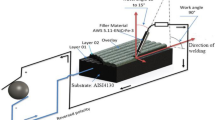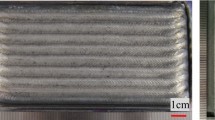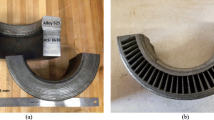Abstract
The effect of post-weld heat treatment (PWHT) on the microstructure, penetration and distribution of hydrogen, and sulfide stress corrosion cracking (SSCC) behavior was investigated to improve the cracking resistance of Inconel 625/X80 dissimilar weld overlay. Among nine candidate PWHT procedures, only the PWHT at 620 °C/20 h could improve the SSCC resistance of the overlay as no crack but only shallow pits were observed in the fusion boundary (FB) region. This PWHT procedure decreased the microhardness, increased the fraction of low-angle grain boundaries, eliminated the susceptible microstructure to hydrogen embrittlement, and therefore enhanced the SSCC resistance of the heat-affected zone. Further, in addition to the decrease of misorientation at the FB, the enhanced SSCC resistance of the FB after PWHT was mainly owing to precipitation of dispersed M23C6 carbides, which may reduce the amount of diffusible hydrogen within the martensite layer and prevent localized hydrogen concentration from reaching the cracking threshold.














Similar content being viewed by others
Data and code availability
The raw/processed data required to reproduce these findings can be shared upon request.
References
Xu LY, Jing HY, Han YD (2018) Effect of welding on the corrosion behavior of X65/Inconel 625 in simulated solution. Weld World 62:363–375. https://doi.org/10.1007/s40194-018-0549-y
Farias F, Da Cruz Payão Filho J, Da Silva Júnior D et al (2019) Microstructural characterization of Ni-based superalloy 625 clad welded on a 9% Ni steel pipe by plasma powder transferred arc. Surf Coat Technol 374:1024–1037. https://doi.org/10.1016/j.surfcoat.2019.06.084
Yin ZF, Zhao WZ, Lai WY et al (2009) Electrochemical behaviour of Ni-base alloys exposed under oil/gas field environments. Corros Sci 51(8):1702–1706. https://doi.org/10.1016/j.corsci.2009.04.019
Mohtadi-Bonab MA, Szpunar JA, Collins L et al (2014) Evaluation of hydrogen induced cracking behavior of API X70 pipeline steel at different heat treatments. Int J Hydrogen Energy 39(11):6076–6088. https://doi.org/10.1016/j.ijhydene.2014.01.138
Jia KN (2011) Effect of heat imput on microstructure and toughness of high strength bridge steel. Adv Mater Res 194:255–258. https://doi.org/10.4028/www.scientific.net/AMR.194-196.255
Yang Y, Shi L, Xu Z et al (2015) Fracture toughness of the materials in welded joint of X80 pipeline steel. Eng Fract Mech 148:337–349. https://doi.org/10.1016/j.engfracmech.2015.07.061
Turichin G, Kuznetsov M, Sokolov M et al (2015) Hybrid laser arc welding of X80 steel: influence of welding speed and preheating on the microstructure and mechanical properties. Phys Procedia 78:35–44. https://doi.org/10.1016/j.phpro.2015.11.015
Pan C, Zhang Z (1994) Characteristics of the weld interface in dissimilar austentic-pearlitic steel welds. Mater Charact 33(2):87–92. https://doi.org/10.1016/1044-5803(94)90070-1
Blicharski M, Rozmus-Górnikowska M (2017) TEM microstructure and chemical composition of transition zone between steel tube and an Inconel 625 weld overlay coating produced by CMT method. Arch Metall Mater 62(2):787–793. https://doi.org/10.1515/amm-2017-0117
Dodge MF, Dong HB, Gittos MF (2014) Effect of post-weld heat treatment on microstructure evolution in dissimilar joints for subsea oil and gas systems. Mater Res Innovations 18(4):907–913. https://doi.org/10.1179/1432891714z.000000000807
DuPont JN (2012) Microstructural evolution and high temperature failure of ferritic to austenitic dissimilar welds. Int Mater Rev 57(4):208–234. https://doi.org/10.1179/1743280412y.0000000006
Dong LJ, Shi ZY, Zhang Y et al (2022) Microstructure and sulfide stress corrosion cracking of the Inconel 625/X80 weld overlay fabricated by cold metal transfer process. Int J Hydrogen Energy 47(67):29113–29130. https://doi.org/10.1016/j.ijhydene.2022.06.210
Mortazavi E, Najafabadi RA, Meysami A (2017) Effect of heat input on microstructure and mechanical properties of dissimilar joints of AISI 316L steel and API X70 high-strength low-alloy steel. J Iron Steel Res Int 24(12):1248–1253. https://doi.org/10.1016/s1006-706x(18)30024-4
Chu Q, Xu S, Tong X et al (2020) Comparative study of microstructure and mechanical properties of X80 SAW welds prepared using different wires and heat inputs. J Mater Eng Perform 29:4322–4338. https://doi.org/10.1007/s11665-020-04986-5
Zhang Y, Dong LJ, Li H et al (2023) Insights into the role of partially mixed zones in sulfide stress corrosion cracking of the inconel 625/X80 weld overlay. Int J Hydrogen Energy 48(73):28583–28600. https://doi.org/10.1016/j.ijhydene.2023.04.061
Zhou C, Huang Q, Guo Q et al (2016) Sulphide stress cracking behaviour of the dissimilar metal welded joint of X60 pipeline steel and Inconel 625 alloy. Corros Sci 110:242–252. https://doi.org/10.1016/j.corsci.2016.04.044
Dai T, Thodla R, Kovacs W et al (2019) Effect of postweld heat treatment on the sulfide stress cracking of dissimilar welds of nickel-based alloy 625 on steels. Corrosion 75(6):641–656. https://doi.org/10.5006/3081
Passos A, Farias F, Oliveira V et al (2021) Sulfide stress cracking susceptibility of the heat-affected zone of an 9% Ni steel welded joint. Constr Build Mater 282:122573. https://doi.org/10.1016/j.conbuildmat.2021.122573
Zhou C, Ye B, Song Y et al (2019) Effects of internal hydrogen and surface-absorbed hydrogen on the hydrogen embrittlement of X80 pipeline steel. Int J Hydrogen Energy 44(40):22547–22558. https://doi.org/10.1016/j.ijhydene.2019.04.239
Park GT, Koh SU, Jung HG et al (2008) Effect of microstructure on the hydrogen trapping efficiency and hydrogen induced cracking of linepipe steel. Corros Sci 50(7):1865–1871. https://doi.org/10.1016/j.corsci.2008.03.007
Wu W, Liu Z, Li X et al (2019) Influence of different heat-affected zone microstructures on the stress corrosion behavior and mechanism of high-strength low-alloy steel in a sulfurated marine atmosphere. Mater Sci Eng, A 759:124–141. https://doi.org/10.1016/j.msea.2019.05.024
Gangloff RP, Somerday BP (2011) Gaseous hydrogen embrittlement of materials in energy technologies: Volume 1—The problem, its characterisation and effects on particular alloy classes. Woodhead Publishing Ltd., Sawston, UK
Zhao MC, Liu M, Atrens A et al (2008) Effect of applied stress and microstructure on sulfide stress cracking resistance of pipeline steels subject to hydrogen sulfide. Mater Sci Eng, A 478(1–2):43–47. https://doi.org/10.1016/j.msea.2007.05.067
Huang F, Liu S, Liu J et al (2014) Sulfide stress cracking resistance of the welded WDL690D HSLA steel in H2S environment. Mater Sci Eng, A 591:159–166. https://doi.org/10.1016/j.msea.2013.10.081
De Jesus Jorge L, Cândido VS, Da Silva ACR et al (2018) Mechanical properties and microstructure of SMAW welded and thermically treated HSLA-80 steel. J Mater Res Technol 7(4):598–605. https://doi.org/10.1016/j.jmrt.2018.08.007
Xu K, Qiao G, Shi X et al (2021) Effect of stress-relief annealing on the fatigue properties of X80 welded pipes. Mater Sci Eng, A 807:140854. https://doi.org/10.1016/j.msea.2021.140854
Wang X, Wang D, Dai L et al (2022) Effect of post-weld heat treatment on microstructure and fracture toughness of X80 pipeline steel welded joint. Materials 15(19):6646. https://doi.org/10.3390/ma15196646
Buzzatti DT, Kanan LF, Dalpiaz G et al (2022) Effect of heat input and heat treatment on the microstructure and toughness of pipeline girth friction welded API 5L X65 steel. Mater Sci Eng, A 833:142588. https://doi.org/10.1016/j.msea.2021.142588
Morales EV, Betancourt G, Fernandes JR et al (2022) Hardening mechanisms in a high wall thickness sour service pipe steel API 5L X65 before and after post-welding heat treatments. Mater Sci Eng, A 851:143612. https://doi.org/10.1016/j.msea.2022.143612
Fenske JA, Robertson IM, Ayer R et al (2012) Microstructure and hydrogen-induced failure mechanisms in Fe and Ni alloy weldments. Metall and Mater Trans A 43:3011–3022. https://doi.org/10.1007/s11661-012-1129-1
Dodge MF, Dong HB, Milititsky M et al (2013) Environment-induced cracking in weld joints in subsea oil and gas systems: Part II. Int Conf Offshore Mech Arctic Eng. Am Soc Mech Eng 55355:V003T03A011. https://doi.org/10.1115/OMAE2013-10339
Dong LJ, Peng Q, Han EH et al (2018) Microstructure and intergranular stress corrosion cracking susceptibility of a SA508-52M-316L dissimilar metal weld joint in primary water. J Mater Sci Technol 34(8):1281–1292. https://doi.org/10.1016/j.jmst.2017.11.051
Dong LJ, Peng QJ, Xue H et al (2018) Correlation of microstructure and stress corrosion cracking initiation behaviour of the fusion boundary region in a SA508 Cl. 3-Alloy 52M dissimilar weld joint in primary pressurized water reactor environment. Corros Sci 132:9–20. https://doi.org/10.1016/j.corsci.2017.12.011
Dong LJ, Zhang Y, Han Y et al (2021) Environmentally assisted cracking in the fusion boundary region of a SA508-Alloy 52M dissimilar weld joint in simulated primary pressurized water reactor environments. Corros Sci 190:109668. https://doi.org/10.1016/j.corsci.2021.109668
Hodgson DK, Dai T, Lippold JC (2015) Transformation and tempering behavior of the heat-affected zone of 2.25 Cr-1Mo steel. Weld J 94(8):250s–256s
Dai T, Lippold JC (2018) Tempering effect on the fusion boundary region of alloy 625 weld overlay on 8630 steel. Weld World 62:535–550. https://doi.org/10.1007/s40194-018-0560-3
Dai T, Lippold JC (2017) Tempering behavior of the fusion boundary region of an F22/625 weld overlay. Weld J 96(12):467s–480s
Dai T, Lippold JC (2018) The effect of postweld heat treatment on hydrogen-assisted cracking of f22/625 overlays. Weld J 97(3):75S-90S. https://doi.org/10.29391/2018.97.007
Sedighi M, Shajari Y, Razavi SH et al (2021) The effect of post weld heat treatment (PWHT) on the microstructure, microhardness and sulphide stress corrosion cracking (SSCC) of Ni-base superalloy IN625 hot wire tig cladding on AISI 4130 Steel. Prot Met Phys Chem Surf 57:113–120. https://doi.org/10.1134/S2070205120060210
Thomas A, Szpunar JA (2020) Hydrogen diffusion and trapping in X70 pipeline steel. Int J Hydrogen Energy 45(3):2390–2404. https://doi.org/10.1016/j.ijhydene.2019.11.096
Momotani Y, Shibata A, Terada D et al (2017) Effect of strain rate on hydrogen embrittlement in low-carbon martensitic steel. Int J Hydrogen Energy 42(5):3371–3379. https://doi.org/10.1016/j.ijhydene.2016.09.188
Han C, Liu Q, Cai Z et al (2022) Effect of solidification segregation on microstructure and mechanical properties of a Ni-Cr-Mo-V steel weld metal. Metall and Mater Trans A 53(4):1394–1406. https://doi.org/10.1007/s11661-022-06600-w
Frei J, Alexandrov BT, Rethmeier M (2019) Low heat input gas metal arc welding for dissimilar metal weld overlays part III: hydrogen-assisted cracking susceptibility. Weld World 63:591–598. https://doi.org/10.1007/s40194-018-0674-7
Bourgeois D, Alexandrov B (2022) Ranking the susceptibility to hydrogen-assisted cracking in dissimilar metal welds. Weld World 66(8):1535–1550. https://doi.org/10.1007/s40194-022-01308-2
Dai T (2018) Effect of postweld heat treatment on the properties of steel clad with alloy 625 for petrochemical applications. The Ohio State University, PhD thesis
Han XL, Wu DY, Min XL et al (2016) Influence of post-weld heat treatment on the microstructure, microhardness, and toughness of a weld metal for hot bend. Metals 6(4):75. https://doi.org/10.3390/met6040075
Jiang W, Ye D, Li J et al (2014) Reverse transformation mechanism of martensite to austenite in 00Cr15Ni7Mo2WCu2 super martensitic stainless steel. Steel Res Int 85(7):1150–1157. https://doi.org/10.1002/srin.201300264
Sinha PP, Sivakumar D, Babu NS et al (1995) Austenite reversion in 18 Ni Co-free maraging steel. Steel Res 66(11):490–494. https://doi.org/10.1002/srin.199501160
Huang CJ, Browne DJ, McFadden S (2006) A phase-field simulation of austenite to ferrite transformation kinetics in low carbon steels. Acta Mater 54(1):11–21. https://doi.org/10.1016/j.actamat.2005.08.033
Nakada N, Mizutani K, Tsuchiyama T et al (2014) Difference in transformation behavior between ferrite and austenite formations in medium manganese steel. Acta Mater 65:251–258. https://doi.org/10.1016/j.actamat.2013.10.067
Bian B, Taheriniya S, Muralikrishna GM et al (2024) Coupling of alloy chemistry, diffusion and structure by grain boundary engineering in Ni–Cr–Fe. Acta Mater 264:119602. https://doi.org/10.1016/j.actamat.2023.119602
Ayer R, Mueller RR, Leta DP et al (1989) Phase transformations at steel/IN626 clad interfaces. Metall Trans A 20:665–681. https://doi.org/10.1007/bf02667584
Zhang J, Dai Z, Zeng L et al (2021) Revealing carbide precipitation effects and their mechanisms during quenching-partitioning-tempering of a high carbon steel: experiments and modeling. Acta Mater 217:117176. https://doi.org/10.1016/j.actamat.2021.117176
Zhao M, Wu H, Zhang B et al (2023) Effect of Cr-rich carbide precipitates on austenite stability and consequent corrosion behavior of ultrafine-grained 304 stainless steel produced by cryogenic rolling and annealing treatment. Mater Charact 195:112553. https://doi.org/10.1016/j.matchar.2022.112553
Capelle J, Gilgert J, Dmytrakh I et al (2008) Sensitivity of pipelines with steel API X52 to hydrogen embrittlement. Int J Hydrogen Energy 33(24):7630–7641. https://doi.org/10.1016/j.ijhydene.2008.09.020
Shen Z, Zhang J, Wu S et al (2022) Microstructure understanding of high Cr-Ni austenitic steel corrosion in high-temperature steam. Acta Mater 226:117634. https://doi.org/10.1016/j.actamat.2022.117634
Hu Y, Wu S, Withers PJ et al (2021) Corrosion fatigue lifetime assessment of high-speed railway axle EA4T steel with artificial scratch. Eng Fract Mech 245:107588. https://doi.org/10.1016/j.engfracmech.2021.107588
Symons DM, Young GA, Scully JR (2001) The effect of strain on the trapping of hydrogen at grain-boundary carbides in Ni-Cr-Fe alloys. Metall and Mater Trans A 32:369–377. https://doi.org/10.1007/s11661-001-0268-6
Regina JR, Dupont JN, Marder AR (2007) The effect of chromium on the weldability and microstructure of Fe-Cr-Al weld cladding. Weld J 86(6):170–178
Martiniano GA, Leal JES, Rosa GS et al (2021) Effect of specific microstructures on hydrogen embrittlement susceptibility of a modified AISI 4130 steel. Int J Hydrogen Energy 46(73):36539–36556. https://doi.org/10.1016/j.ijhydene.2021.08.147
Ramirez MFG, Hernández JWC, Ladino DH et al (2021) Effects of different cooling rates on the microstructure, crystallographic features, and hydrogen induced cracking of API X80 pipeline steel. J Market Res 14:1848–1861. https://doi.org/10.1016/j.jmrt.2021.07.060
Cui X, Zhang S, Wang C et al (2020) Effects of stress-relief heat treatment on the microstructure and fatigue property of a laser additive manufactured 12CrNi2 low alloy steel. Mater Sci Eng, A 791:139738. https://doi.org/10.1016/j.msea.2020.139738
Ospina-Correa JD, Olaya-Muñoz DA, Toro-Castrillón JJ et al (2021) Grain polydispersity and coherent crystal reorientations are features to foster stress hotspots in polycrystalline alloys under load. Sci Adv 7(15):eabe3890. https://doi.org/10.1126/sciadv.abe3890
Maresca F, Curtin WA (2017) The austenite/lath martensite interface in steels: structure, athermal motion, and in-situ transformation strain revealed by simulation and theory. Acta Mater 134:302–323. https://doi.org/10.1016/j.actamat.2017.05.044
Acknowledgements
This work is supported by the National Natural Science Foundation of China (No. 52001264)
Author information
Authors and Affiliations
Contributions
Lijin Dong: conceptualization, methodology, data curation, funding acquisition, writing—original draft. Guiyu Wu: writing—original draft, investigation; Yan Zhang: investigation; Zhenyan Shi: investigation; Shidong Wang: supervision; Qinying Wang: supervision, funding acquisition; Li Liu: validation: supervision.
Corresponding author
Ethics declarations
Conflicts of interest
The authors declare no competing financial interest.
Ethical approval
Not applicable.
Additional information
Handling Editor: Zhao Shen.
Publisher's Note
Springer Nature remains neutral with regard to jurisdictional claims in published maps and institutional affiliations.
Rights and permissions
Springer Nature or its licensor (e.g. a society or other partner) holds exclusive rights to this article under a publishing agreement with the author(s) or other rightsholder(s); author self-archiving of the accepted manuscript version of this article is solely governed by the terms of such publishing agreement and applicable law.
About this article
Cite this article
Dong, L., Wu, G., Zhang, Y. et al. Improvement of sulfide stress corrosion cracking resistance of the Inconel 625/X80 weld overlay by post-weld heat treatment. J Mater Sci (2024). https://doi.org/10.1007/s10853-024-09731-0
Received:
Accepted:
Published:
DOI: https://doi.org/10.1007/s10853-024-09731-0




